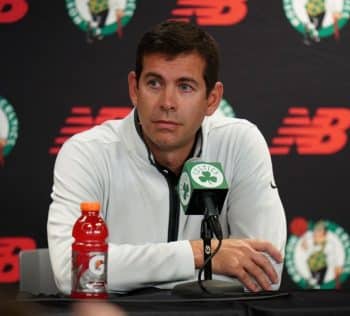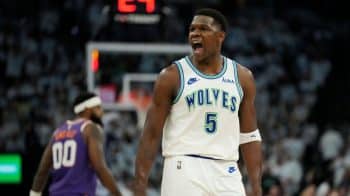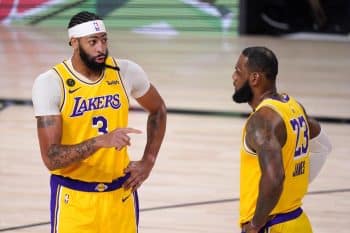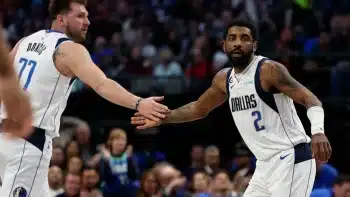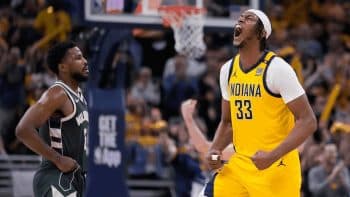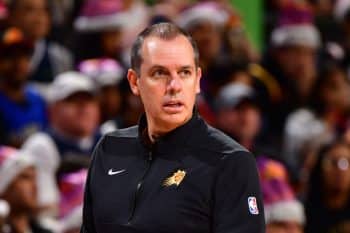NBA
NBA Sunday: There’s an Art Behind Tanking

It was 30 long years ago, way back in 1985, that Commissioner David Stern made the announcement that would help resurrect basketball in New York City.
In the NBA’s first ever draft lottery, the New York Knicks won the first overall pick. In other words, they won the right to draft Patrick Ewing—the consensus top talent available.
Over the course of his long, 15-year career in New York, Ewing would lead a revival and help the Knicks rise from the doldrums. And behind Ewing, they would eventually emerge as contenders.
From then, the rest of the league’s teams looked at the lottery not simply as a parade of losers celebrating their ineptitude, but as a light at the end of the tunnel—a sparkle of hope glistening far off in the distance.
The first five draft lotteries were all conducted in the same unscientific way. Each lottery team had an equal opportunity of securing the first overall pick until 1990. That’s when the modern lottery system was first implemented.
Since then, the league has weighted the lottery toward the teams with the worst records. The lottery teams would each have an opportunity to obtain a top-three pick with the teams having odds based on their regular season record, ranked in reverse order. By virtue of the system, the teams with the top-three worst records were guaranteed no worse than the fourth, fifth and sixth picks, respectively.
Over the course of the 30 years in which the draft lottery has become a staple of the NBA’s culture, there has been reform. Still, today, the league is currently looking to adjust the rules and procedures behind the draft lottery, as it currently incentivizes losing by giving the team with the worst record the highest odds of securing the top overall pick.
Over the course of the past seven years in the NBA, in the period immediately proceeding the assembling of the eventual 2008 NBA Champion Boston Celtics, teams began to get more top-heavy. From then, it became apparent that it took three to tango for an NBA title, and that’s exactly what the eventual contenders assembled.
Immediately thereafter, Pau Gasol was dealt to the Los Angeles Lakers, Shaquille O’Neal traded to the Phoenix Suns and Jason Kidd sent to the Dallas Mavericks. The talent arms race was on while teams like the Oklahoma City Thunder, Portland Trail Blazers and Golden State Warriors built their contenders slowly and steadily, mostly through the draft.
Teams in the league eventually began falling into one of two categories: those that sought free agency and trade acquisitions for building their contenders versus those that did it naturally and organically through the draft.
The 2008 Celtics trade and the eventual ratification of the 2011 collective bargaining agreement have together yielded an NBA culture wherein draft picks have a higher perceived value than ever before. The end result has been egregious tanking on the part of more than one NBA team. The Orlando Magic and Philadelphia 76ers immediately come to mind, but this season, the team that seems to be pulling the most obvious tank-job is the New York Knicks.
With Phil Jackson having recently taken over and installing Derek Fisher as his head coach, he sought to revamp the roster he inherited and has already shipped out veterans Tyson Chandler, Raymond Felton, J.R. Smith and Iman Shumpert. The lack of tangible assets received in return and the fact that the Knicks own their 2015 first-round pick is all the evidence one needs.
With the Knicks entering play on January 25 with the league’s second-worst record, they are doing quite well in their tanking effort, but if there is one thing that history has taught us, it’s that it would behoove the Knicks to win a few more games.
——
With the opportunity to draft a franchise-altering talent, it is understandable that teams in need of an infusion of talent would try to improve their odds of securing the top overall pick. It is for that reason that tanking has become “a thing” and it is difficult to argue with the merits.
Between 1985 and 2012, the exhaustive list of players selected with the first overall pick, in order:
Patrick Ewing, Brad Daugherty, David Robinson, Danny Manning, Pervis Ellison, Derrick Coleman, Larry Johnson, Shaquille O’Neal, Chris Webber, Glenn Robinson, Joe Smith, Allen Iverson, Tim Duncan, Michael Olowokandi, Elton Brand, Kenyon Martin, Kwame Brown, Yao Ming, LeBron James, Dwight Howard, Andrew Bogut, Andrea Bargnani, Greg Oden, Derrick Rose, Blake Griffin, John Wall, Kyrie Irving and Anthony Davis.
Of those 28 players taken with the first overall pick, only seven—Ellison (1989), Smith (1995), Olowokandi (1998), Brown (2001), Bogut (2005), Bargnani (2006) and Oden (2007) —would fail to make a single All-Star appearance over the course of their careers.
In other words, although having the first overall selection in a draft does not necessarily ensure a team of getting the best player of the draft, a general manager can go to sleep knowing that 75 percent of first overall picks drafted since 1985 at least make an All-Star appearance or two.
Of those 28 players, 15 of them are either already in or will likely be in the Hall-of-Fame when it’s all said and done; again, those are not terrible odds.
Securing the top overall pick guarantees nothing, of course. In many cases, the best player from a draft doesn’t necessarily get selected with the first overall pick. The most obvious examples of that fact can be found in the 1995, 1996 and 1998 drafts. The consensus top player from each class—Kevin Garnett in 1995, Kobe Bryant in 1996 and Dirk Nowitzki in 1998—were selected with the fifth, 13th and ninth picks, respectively.
With respect to Bryant and the 1996 draft, the draft will be regarded as one of the best in history. Ten players selected in the first round made at least one All-Star appearance and while there were some misses, Bryant was selected behind surefire talents that included Allen Iverson, Shareef-Abdur Rahim, Stephon Marbury, Ray Allen and Antoine Walker.
The same can be said of the almighty 2003 class. LeBron James was correctly selected first overall, but the draft will almost certainly go down as being the only one in the lottery era to feature four Hall-of-Famers taken within the first six selections.
In 1998, though, it was a much different story. The top three picks were all relative misses. Michael Olowokandi, Mike Bibby and Raef LaFrentz went with the first three picks while Antawn Jamison and Vince Carter were selected fourth and fifth, respectively. Nowitzki would eventually be selected at nine with Paul Pierce being selected right behind him at 10th.
To a large degree, determining who to draft is a bit of a crap shoot. Winning the pick is a blessing, but botching it is something that can set a franchise back a number of years.
In 1998, the Los Angeles Clippers selected Olowokandi first and in 2007, the Portland Trail Blazers selected Greg Oden.
Rest assured, each franchise would like a do-over.
Still, given the choice, anyone would prefer to select sooner rather than later. Being that there are few guarantees in life, though, it should come as no surprise that not even tanking guarantees anything.
——
Since the NBA implemented its weighted lottery back in 1990, it has held 25 weighted lotteries.
History has shown that if a team wants to end up with the top overall pick, it would be best served by not finishing with the worst overall record, but perhaps somewhere between third-worst and fifth-worst.
Since 1990, surprisingly, the team with the worst record has won the draft lottery only three times (as noted in the table below). In 1990, the New Jersey Nets won the lottery and selected Coleman. In 2003, the Cleveland Cavaliers did so and selected James and the following year, in 2004, the Orlando Magic won the lottery and selected Howard.
Amazingly, 12 draft lotteries would come and go between 1990 and 2003 and none of those 12 saw the team with the best odds securing the top overall pick. Although the same happened in 2004, since then, 10 more draft lotteries have gone by without the team with the highest odds winning.
Historically, the teams with the third and fifth best odds of winning the draft lotteries have been most fortunate.
Since 1990, the team with the third best odds of winning has won the draft lottery six times, including three times in a row in the late 1990s and two of the three immediately preceding lotteries.
The San Antonio Spurs, in 1997, had the third-worst record in the league but managed to win the top pick that yielded Tim Duncan. Olowokandi (1998), Elton Brand (1999), Kwame Brown (2001) and, more recently, Anthony Davis (2012) and Anthony Bennett (2013) were all chosen by teams who finished not with the league’s worst record, but third worst.
Teams finishing the season with the fifth-worst record fare almost as well. Since 1990, they have won the draft lottery five times: 1991 (Larry Johnson), 1995 (Joe Smith), 2002 (Yao Ming), 2006 (Andrea Bargnani) and 2010 (John Wall).
In all fairness, at least two of the aforementioned picks may be referred to as busts, but that’s more a reflection on the front office exercising the pick than it is on the system that yielded it.
Historically, even the team with the second-worst record has done better than the team with the worst record. The team with the second-worst record has won four draft lotteries since 1990; 1992, 1994, 1996 and 2009. Those picks yielded Shaquille O’Neal, Glenn Robinson, Allen Iverson and Blake Griffin, respectively.
Interestingly enough, the team with the fourth-worst record has never won the draft lottery. But according to the data, teams have fared better in the draft lottery by finishing not with the worst overall record, but either fifth-worst, third-worst or second-worst.
——
At the end of the day, drafting an All-Star is a difficult endeavor, much less a Hall-of-Famer who has the ability to elevate a franchise. There are few sure things in the world of professional sports, especially as it relates to drafting players.
Still, so long as the NBA employs its currently weighted drafting system, there will be incentive for teams to do all that they can to accrue losses. With players like Andrew Wiggins, Anthony Davis, Kyrie Irving, John Wall, Blake Griffin and Derrick Rose seemingly helping their respective franchises reverse their fortunes overnight, it is quite understandable that teams would tank in an effort to try to secure the next star.
Someone should let Phil Jackson in on the secret, though. Historically, it is not the team with the worst-record that has fared best in the draft lottery.
Someone, quick, tell the Zen Master, there’s an art to tanking.
NBA DRAFT LOTTERY WINNERS SINCE 1990
| Year | Winner | Lottery Odds | Selection |
| 1990 | New Jersey Nets | 1 | Derrick Coleman |
| 1991 | Charlotte Hornets | 5 | Larry Johnson |
| 1992 | Orlando Magic | 2 | Shaquille O’Neal |
| 1993 | Orlando Magic | 11 | Chris Webber |
| 1994 | Milwaukee Bucks | 2 | Glenn Robinson |
| 1995 | Golden State Warriors | 5 | Joe Smith |
| 1996 | Philadelphia 76ers | 2 | Allen Iverson |
| 1997 | San Antonio Spurs | 3 | Tim Duncan |
| 1998 | Los Angeles Clippers | 3 | Michael Olowokandi |
| 1999 | Chicago Bulls | 3 | Elton Brand |
| 2000 | New Jersey Nets | 7 | Kenyon Martin |
| 2001 | Washington Wizards | 3 | Kwame Brown |
| 2002 | Houston Rockets | 5 | Yao Ming |
| 2003 | Cleveland Cavaliers | 1 | LeBron James |
| 2004 | Orlando Magic | 1 | Dwight Howard |
| 2005 | Milwaukee Bucks | 6 | Andrew Bogut |
| 2006 | Toronto Raptors | 5 | Andrea Bargnani |
| 2007 | Portland Trail Blazers | 6 | Greg Oden |
| 2008 | Chicago Bulls | 9 | Derrick Rose |
| 2009 | Los Angeles Clippers | 2 | Blake Griffin |
| 2010 | Washington Wizards | 5 | John Wall |
| 2011 | Cleveland Cavaliers | 8 | Kyrie Irving |
| 2012 | New Orleans Pelicans | 3 | Anthony Davis |
| 2013 | Cleveland Cavaliers | 3 | Anthony Bennett |
| 2014 | Cleveland Cavaliers | 9 | Andrew Wiggins |
